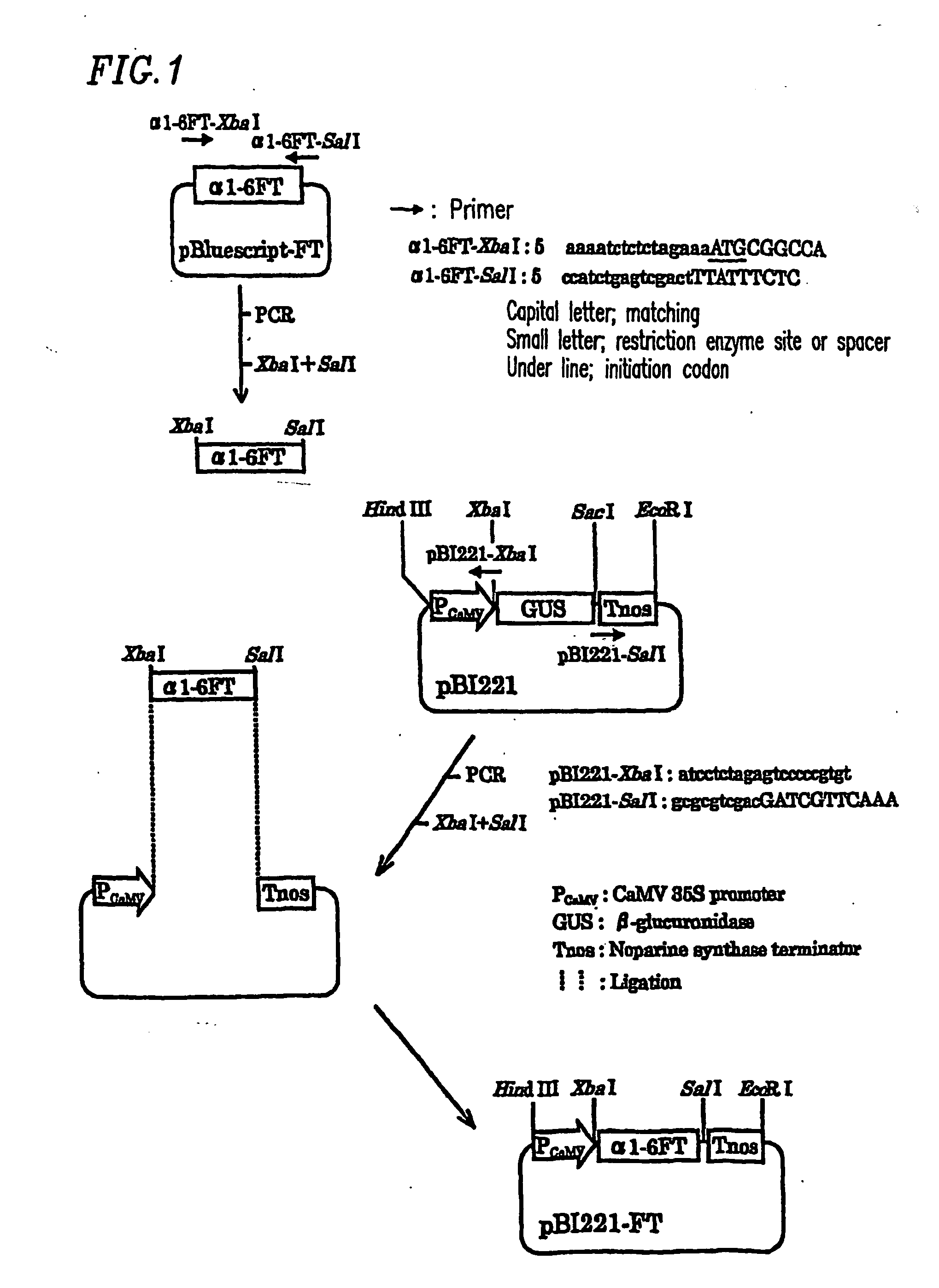Plant cell having animal-type sugar chain adding function
a plant cell and function technology, applied in the field of plant cells having an animal-type sugar chain adding function, can solve the problem that proteins do not exhibit an inherent activity
- Summary
- Abstract
- Description
- Claims
- Application Information
AI Technical Summary
Benefits of technology
Problems solved by technology
Method used
Image
Examples
example 1
Introduction of α1,6-fucosyl transferase gene (hereinafter referred to as α1,6-FT) into cultured tobacco cells
[0076] Introduction of the α1,6-fucosyl transferase gene into cultured tobacco cells was conducted using Agrobacterium capable of infecting plant cells. A. tumefaciens is often used to transform dicotyledons. Recently, it has been shown that a group of genes encoded in the vir region on a Ti plasmid are involved in oncogenesis. When infecting plants, Agrobacterium receives phenol substances secreted by dicotyledons as an infection signal, and then activates the transcription of the vir gene group. As a result, several proteins encoded by the vir genes cut, transfer, and incorporate a T-DNA gene. T-DNA and the vir genes are not individually capable of oncogenesis. Even if T-DNA and the vir genes are present on separate replicons but in the same Agrobacterium cell, T-DNA and the vir genes are collectively capable of oncogenesis. A method for introducing an exogenous gene usin...
example 2
Influence of α1,6-FT on Glycoprotein in Cultured tobacco cell
[0096] Influence of the introduced α1,6-FT on glycoproteins in BY2-FT cells was studied using pea lectin (PSA) which is strongly linked to a fucose residue α1,6 linked to N-acetylglucosamine existing at the reducing terminal of an asparagine-linked type sugar chain. First, a crude protein extract solution was prepared from a BY2-FT cell in accordance with a method described in the Materials and Methods section 14. The approximate value of the crude protein concentration was obtained by measuring absorbance A280 (the Materials and Methods section 15). The crude protein extract solution was subjected to SDS-PAGE in accordance with the Materials and Methods sections 16 and 17 below. Thereafter, lectin staining was conducted.
[0097] As a result, referring to FIG. 8, the glycoprotein sugar chain in the transformant cells exhibited a stain corresponding to about 23 kDa which means a reaction with lectin, as compared to non-tran...
example 3
Analysis of Glycoprotein Produced by Transformed Cultured tobacco cells
[0098] Three BY2-FT strains having the highest growth rate were selected. The sugar chain structure of glycoproteins produced by transformed cells having an introduced α1,6-FT gene was analyzed.
[0099] 1. Preparation of Glycoproteins Produced by Strain BY2-FT 3
[0100] Cultured cells (a wet weight of about 3 kg) of BY2-FT 3 (cultured tobacco cells) were subjected to pulverization with a glass homogenizer, thereby obtaining cell lysates. These cell lysates were centrifuged at 12,000 rpm for 20 minutes at 4° C., thereby obtaining supernatants including glycoproteins. The supernatants were dialyzed with dH2O (deionized water) (1.5×104-fold dilution) followed by lyophilization, thereby obtaining powdered specimens.
[0101] 2. Preparation of N-linked Sugar Chains
[0102] Thereafter, these powdered specimens were subjected to hydrazinolysis at 100° C. for 10 hours, thereby cutting out sugar chains from glycoproteins. An ...
PUM
| Property | Measurement | Unit |
|---|---|---|
| time | aaaaa | aaaaa |
| acid | aaaaa | aaaaa |
| structure | aaaaa | aaaaa |
Abstract
Description
Claims
Application Information
 Login to View More
Login to View More - R&D
- Intellectual Property
- Life Sciences
- Materials
- Tech Scout
- Unparalleled Data Quality
- Higher Quality Content
- 60% Fewer Hallucinations
Browse by: Latest US Patents, China's latest patents, Technical Efficacy Thesaurus, Application Domain, Technology Topic, Popular Technical Reports.
© 2025 PatSnap. All rights reserved.Legal|Privacy policy|Modern Slavery Act Transparency Statement|Sitemap|About US| Contact US: help@patsnap.com



